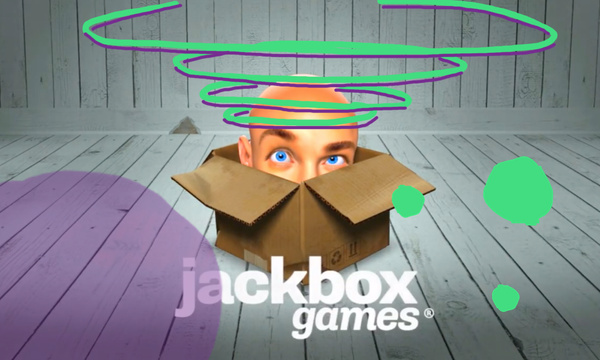This article first appeared on TechCrunch
During this period of shelter-in-place, people have had to seek out new forms of entertainment and social interaction. Many have turned to a niche party series made by a company best known for an irreverent trivia game in the ’90s called “You Don’t Know Jack.”
Since 2014, the annual release of the Jackbox Party Pack has delivered 4-5 casual party games that run on desktop, mobile and consoles that can be played in groups as small as two and as large as 10. In a clever twist, players use smartphones as controllers, which is perfect for typing in prompts, selecting options, making drawings, etc.
The games are tons of fun and perfect for playing with friends over video conference, and their popularity has skyrocketed, as indicated by Google Trends. I polled my own Twitter following and found that nearly half of folks had played in the last month, though a full third hadn’t heard of Jackbox at all.

How do these games work?
There are over 20 unique games across the Jackbox Party Packs 1-6, too many to explain them all but here are three of the most popular ones.
- Fibbage: a twist on the traditional trivia game, players are asked to invent an answer to a question of obscure knowledge (e.g ” A Swedish man who works as a dishwasher receives disability benefits due to his unusual addiction to ____.”) Then all the invented answers are mixed in with the truth and players have to select the real answer while avoiding fakes. You earn points for guessing correctly and for tricking other players. (Btw, the answer is “heavy metal”)

- Quiplash: Similar to Cards Against Humanity, but with more creativity. Players respond to pre-written prompts “What the boogeyman is afraid of?” and the group votes on head-to-head answers. Later versions allowed you to write custom questions (which could work well for a birthday party or bridal shower)

- Drawful: A twist on Pictionary, players draw a visual depiction of strange prompts like “Milkshakes from the milkshake tree” or “Low-speed chase”. Similar to Fibbage, players have a chance to give prompts to all the drawings and then try to select the real prompt while avoiding the fakes.

Almost all the games stick to a formula combining funny prompts, trivia, drawing, clever responses, betting and voting on answers, yet new entries continue to keep it fresh.
What makes them so fun?
While Jackbox clearly owes a great deal of its current popularity to shelter- in-place policies, it’s also been honing their craft for years, with each party pack improving upon the last. It’s worth looking at what makes them work:
- Easy to pick up: While some games are a bit more complex, most can be explained in less than 30 seconds or simply intuited as you play. I’ve hosted games with my family, co-workers and friends who otherwise never play video games, and getting started has not been an issue. Compare that to many board games that take 30 minutes or more to simply explain and set up.
- Surprising: Jackbox packs a ton of novelty into its games. The facts they pull up for Fibbage are very weird but oddly fascinating (e.g. a man in Tennessee was arrested after committing 11 felonies in nine hours). The Drawful prompts are very bizarre and the Quiplash prompts are similarly varied and funny.
- Well-paced: The games are quick to play, taking between 15-20 minutes per session, and scale well between smaller and larger groups. Players have time pressure to complete their responses, so you’re never stuck waiting for one person to finish. That means that there’s always time for a quick game, and, if you’re having fun, a chance to do “just one more round.”

- Comeback mechanics – Party games are less about evaluating who’s truly the best at knowing trivia / drawing abstract concepts / being funny and more about having a good time. So Jackbox implements a number of comeback mechanics, which allows players who are behind in points to catch up. Sometimes that just means increasing the point value of guessing correctly as the game progresses to close an early lead, and other times it means actually penalizing the current leader with a more difficult challenge. This means people are engaged through the end of the game.
- Screw opportunities – Games are a great way to burn your friends—with Jackbox, it’s usually with inside jokes as answers to prompts. But the games also often feature ways to screw other players, often with a literal “screw” item which can be used to force another player to do something, or makes responding harder (you have to type in a password before choosing a prompt)
Lessons for product creators
Games are obviously an entertainment product, and while gamification was a hot topic in certain circles, most companies don’t look to games for inspiration when designing their products and services. But Jackbox isn’t a traditional game, and because it relies so much on group dynamics, there’s a lot to be learned, especially for products that facilitate collaboration or social interaction.
Personality – Jackbox’s zaniness is a refreshing change to the bland voice and tone of most products these days. It feels like most companies just want to play it safe and hold back in this area. Apps like Discord, with delightful little animations and clever copy and Google Assistant’s 30+ person team of comedians, filmmakers, and artists show you can have personality without sacrificing reach.
Wagering – some Jackbox games that are about choosing the right answer (often trivia related) allow you to “double down” for extra points. There’s something fun about not just being right, but being extra right. How can product creators leverage this? One idea is with any product that does A/B testing. If I’m sending an email in Convertkit, maybe I can guess which subject line will do better and be recognized for guessing correctly. Even better if my whole team can guess along with me.

Visually distinct – the growth of design systems have largely been a boon as designers could now make changes in a single place, changing the secondary font for instance, and having it deploy across the site or app. But this has also led to a feeling of sameness when browsing a large platform – and it makes it harder to experiment or make changes overall. Jackbox games all look and feel very distinct from each other. Fibbage 3 has a 70’s vibe to it while Push The Button takes place in a spaceship. I want to see more companies do what Facebook and Foursquare did by actually splitting their product into standalone apps. Or you can at least make them more visually distinct like Amazon Prime Video’s darker theme over the bright shopping section.
Experimentation – most product teams brainstorm tons of ideas and eventually just just a tiny handful with actual users. Jackbox takes a broader approach. According to their chief creative officer Allard Laban in 2017:
We will spend a few months dedicating a day each week to prototyping and paper-and-pencil testing gameplay.
For the unreleased Jackbox Party Pack 4, we created over 50 play-tested concepts.
They even shelved several game ideas and brought them back in later party pack. That commitment to breadth and iteration has unleashed a tremendous amount of creativity

Better avatars – Jackbox has great avatars and as more products lean into collaboration, they’ll require avatars too. Of course most people end up making their avatar a photo of their face, but I think we should be raising the bar on the default avatar. Many are just your first initial in a circle or maybe an arbitrary animal for fully anonymous users (looking at you Google Docs). Jackbox proves we can do and should do better.
At the end of the day, most product companies don’t make fun games, they build productivity tools, or design services, or physical devices. But even still, the success and appeal of Jackbox Games gives every product creator some inspiration on how to make something simple, fun, and memorable.

